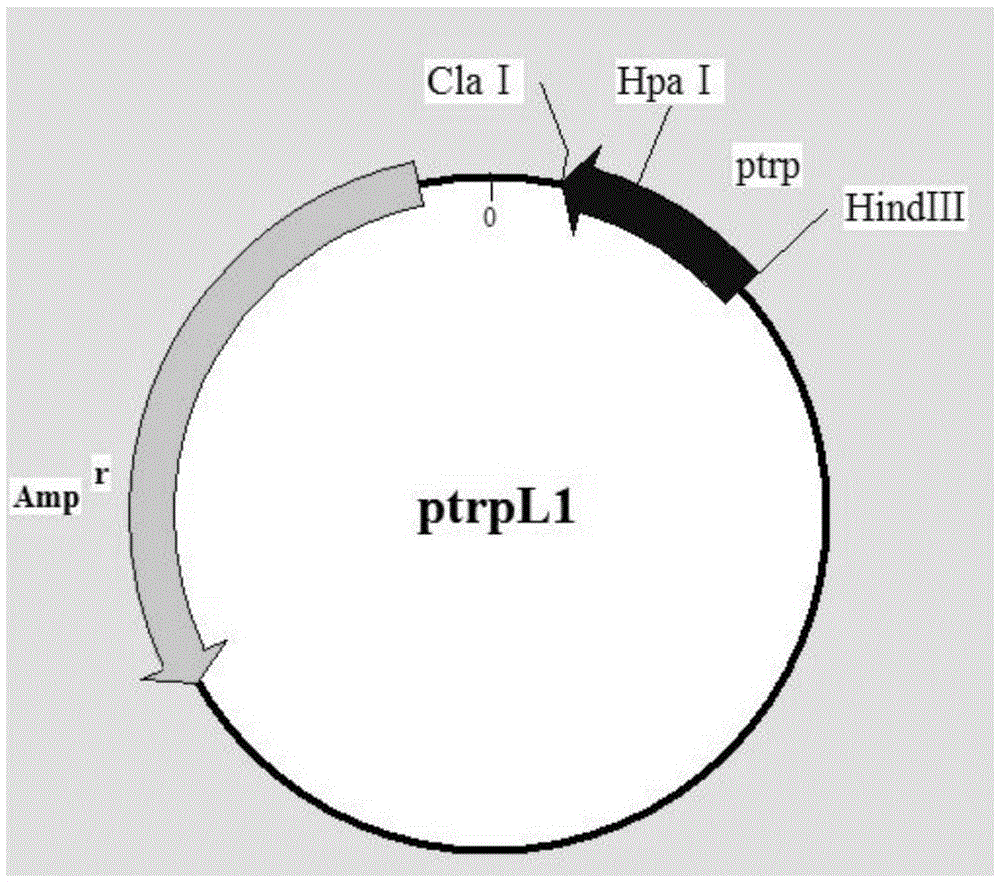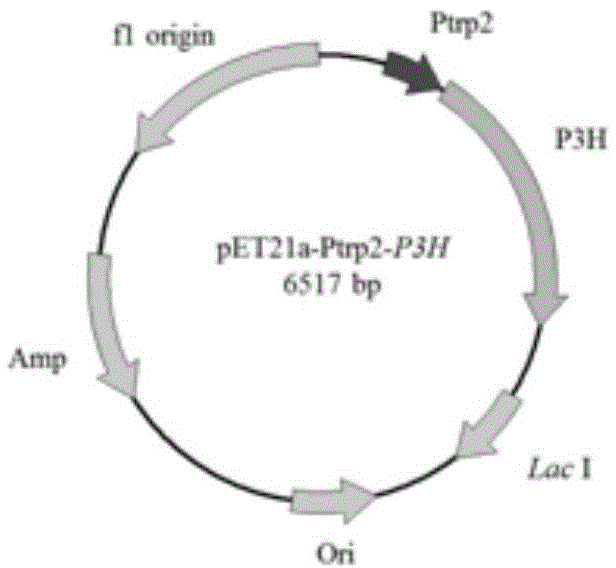Method for effectively improving proline conversion rate in system for producing Cis-3-hydroxy-L-proline according to biosynthesis method
A technology of proline conversion rate and biosynthesis, which can be used in biochemical equipment and methods, microorganisms, nucleic acid carriers, etc., and can solve problems such as low content
- Summary
- Abstract
- Description
- Claims
- Application Information
AI Technical Summary
Problems solved by technology
Method used
Image
Examples
Embodiment 1
[0023] Example 1: Design of tryptophan tandem promoter sequence
[0024] The tryptophan tandem promoter is derived from the ptrpL1 plasmid, and the plasmid map is attached to the instructions figure 2 The tryptophan promoter of this plasmid is derived from the tryptophan operon of Escherichia coli K12 strain. It is a strong promoter suitable for industrial production applications. There is a ClaI restriction site between the SD sequence and the start codon sequence , At the same time, there is a HindⅢ enzyme cutting site upstream of the -35 region of the tryptophan promoter, which is convenient for connecting the promoter to other expression vectors. Since two tryptophan promoters can be connected in tandem to increase the expression intensity, according to the tryptophan promoter sequence of the ptrpL1 plasmid, a tryptophan tandem promoter was synthesized in the whole gene.
[0025] By optimizing the tryptophan tandem promoter, the HindⅢ restriction site AAGCTT was modified...
Embodiment 2
[0027] Embodiment 2: the design of proline-3-hydroxylase gene sequence
[0028] According to the codon usage frequency of Escherichia coli to optimize gene codons, eliminate codons with low usage rate, and use the synonymous transformation method to eliminate the EcoRI restriction site, modify the terminator in the original sequence to a TAAT strong terminator, in order to It is convenient to connect the proline-3-hydroxylase gene to other plasmid vectors, so a restriction site BamHI (GGATCC) was inserted behind the terminator.
[0029] The secondary structure of mRNA should also be taken into consideration. First, ensure that the codon translation pocket consisting of the ATG initiation codon and several bases thereafter is open, reducing the energy potential of ribosomes binding to mRNA, making ribosomes Can be smoothly translated backwards along the start codon.
[0030] The optimized proline 3-hydroxylase gene sequence in this embodiment is artificially synthesized; see S...
Embodiment 3
[0031] Embodiment 3: the construction of proline 3-hydroxylase gene expression vector
[0032] First, synthesize the designed tryptophan tandem promoter and proline 3-hydroxylase gene respectively. Since the 5' end sequence of the tryptophan tandem promoter gene sequence has an EcoRI (GAATTC) restriction site, the 3' end There is a HindⅢ (AAGCTT) restriction site, and the 5' end sequence of the proline 3-hydroxylase gene has a HindⅢ (AAGCTT) restriction site, while the 3' end has a BamHI (GGATCC) restriction site.
[0033] The tryptophan tandem promoter gene sequence was double-digested with restriction endonucleases EcoRI and HindⅢ, and the proline 3-hydroxylase gene was double-digested with HindⅢ and BamHI. At the same time, the plasmid vector pET21a was also digested with EcoRI and BamHI digestion. The tryptophan tandem promoter gene sequence, proline 3-hydroxylase gene and pET21a plasmid vector after the double-cut enzyme were recovered with an agarose gel kit, and then t...
PUM
 Login to View More
Login to View More Abstract
Description
Claims
Application Information
 Login to View More
Login to View More - R&D
- Intellectual Property
- Life Sciences
- Materials
- Tech Scout
- Unparalleled Data Quality
- Higher Quality Content
- 60% Fewer Hallucinations
Browse by: Latest US Patents, China's latest patents, Technical Efficacy Thesaurus, Application Domain, Technology Topic, Popular Technical Reports.
© 2025 PatSnap. All rights reserved.Legal|Privacy policy|Modern Slavery Act Transparency Statement|Sitemap|About US| Contact US: help@patsnap.com



